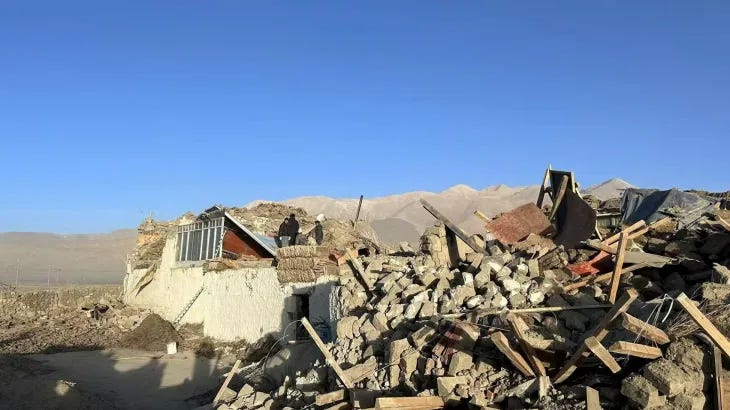Powerful Earthquake Strikes Tibet’s Shigatse, Killing Over 120
Rescue Efforts Conclude as Authorities Shift Focus to Recovery
A devastating earthquake struck a remote region of Tibet, leaving at least 126 people dead and more than 100 injured. The powerful tremor was felt across Nepal, Bhutan, and parts of northern India, with significant damage reported in the affected areas.
Chinese state broadcaster CCTV aired footage showing widespread destruction, with the official Xinhua News Agency confirming that over 1,000 homes sustained damage. The earthquake’s epicenter was identified in Shigatse, a city of great religious significance in Tibet.
Magnitude and Location of the Quake
The United States Geological Survey (USGS) reported that the earthquake registered at 7.1 on the Richter scale, while the China Earthquake Networks Center (CENC) recorded a slightly lower magnitude of 6.8. The tremor struck just after 9:05 a.m. local time (01:05 GMT) at a shallow depth of approximately 10 km (6 miles).
The epicenter was in Dingri County, a high-altitude region near Mount Everest on the Chinese side, home to around 62,000 people. According to CENC, this earthquake is the strongest recorded within a 200 km (124-mile) radius in the past five years.
Shigatse is also the seat of the Panchen Lama, an important figure in Tibetan Buddhism, second in authority only to the Dalai Lama.
Harsh Weather Complicates Rescue Efforts
The disaster struck amid extreme winter conditions. Dingri County was experiencing temperatures as low as -8°C (17.6°F), with forecasts predicting a further drop to -18°C by the evening. The region’s remoteness, combined with freezing temperatures, has hampered rescue operations, according to Al Jazeera’s correspondent Katrina Yu, reporting from Beijing.
Casualties and Injuries
As of Tuesday evening (11:00 GMT), the death toll stood at 126, with at least 188 others injured, according to reports from Xinhua. The powerful tremors also reached Nepal, where a man in Kathmandu sustained injuries after jumping off a building in fear. However, no other casualties have been reported in Nepal, India, or Bhutan.
Extent of Damage
The earthquake caused significant structural damage. More than 1,000 houses have been affected, with some buildings completely reduced to rubble. According to CCTV, Dingri County and surrounding areas experienced strong tremors, leading to numerous collapses.
In the town of Lhatse, videos analyzed by AFP showed debris scattered along streets and outside restaurants.
Areas Affected by the Tremors
The earthquake’s impact extended beyond Tibet, with tremors reported in Nepal’s capital, Kathmandu, about 230 km (140 miles) south of Shigatse. Residents rushed out of their homes in panic as aftershocks continued.
Tremors were also felt in the northern Indian state of Bihar, which borders Nepal, and as far as Thimphu, the capital of Bhutan. Nepal’s National Disaster Risk Reduction and Management Authority (NDRRMA) confirmed that seven hill districts bordering Tibet experienced shocks.
Government Response and Relief Measures
With the search for survivors now concluded, efforts are shifting towards helping the 46,000 people displaced by the earthquake.
The Chinese government initially deployed 1,500 rescue workers, including military personnel, to the affected areas. Reports showed images of injured individuals receiving treatment on the streets.
Authorities have sent around 22,000 relief items, including cotton tents, quilts, and other essential supplies suited for high-altitude regions. Chinese President Xi Jinping has urged an all-out effort to minimize casualties and ensure the safety and warmth of displaced residents through the harsh winter months, according to CCTV.
Local officials continue to assess the full extent of the damage and aid requirements.
Seismic Activity in the Himalayan Region
The Tibetan Plateau is prone to frequent earthquakes due to the collision of tectonic plates. Tibet and Nepal sit on a major geological fault line where the Indian plate pushes against the Eurasian plate, forming the towering Himalayas. As a result, the region regularly experiences seismic activity.
Seismologist Marianne Karplus emphasized the need for earthquake education and resilient infrastructure to mitigate future disasters. "While we cannot predict earthquakes, scientific studies can help us understand the causes of seismic activity in Tibet and the potential impacts," said Karplus, a professor of geological sciences at the University of Texas at El Paso.
Over the past five years, 29 earthquakes of magnitude 3 or higher have been recorded within 200 km (124 miles) of the Shigatse epicenter. However, Tuesday’s quake was significantly more powerful than previous ones, Al Jazeera’s Yu reported.
The region has a history of devastating earthquakes. In 2015, a 7.8-magnitude quake in Nepal killed nearly 9,000 people and injured over 22,000, destroying more than half a million homes. In May 2021, a magnitude 7.3 earthquake struck China’s Qinghai province.
Tuesday’s earthquake is now considered one of the most severe to hit the Himalayan region in the past century.


